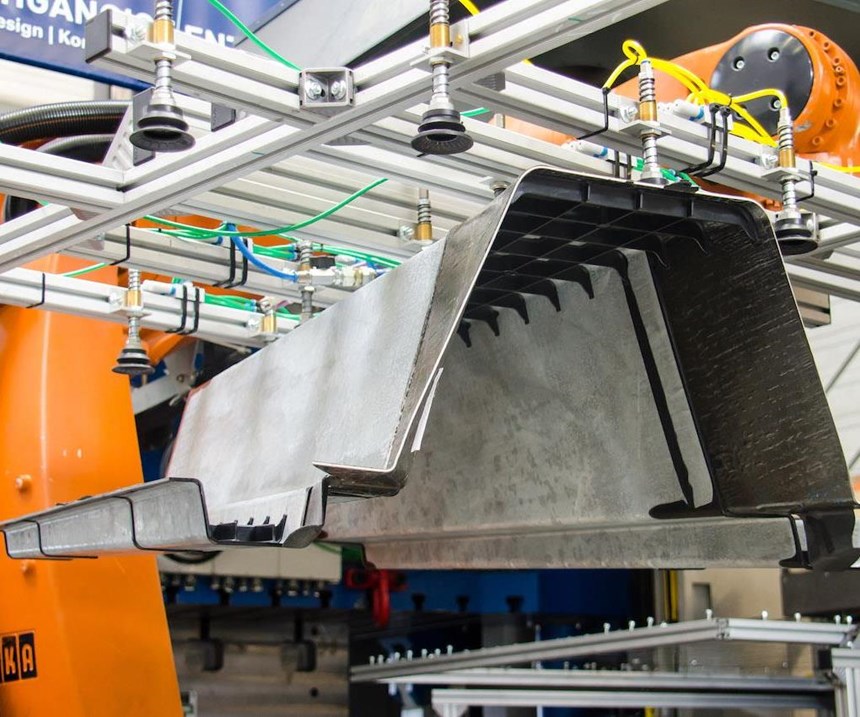KraussMaffei's new one-step forming and back injection for composites
KraussMaffei is working on the development of new hybrid materials and processes in collaboration with the Dresden University of Technology.
KraussMaffei Technologies GmbH (Munich, Germany) is working on the development of new hybrid materials and processes in collaboration with the Dresden University of Technology in Germany. Called the LEIKA research project, the new lab system is at the Institute for Lightweight Engineering and Polymer Technology. This system allows FRP-metal hybrid materials to be formed and back injected in one step.
The objective of the research project supported by the German Federal Ministry of Education and Research is to decrease the structural mass in electric vehicles by using innovative hybrid materials with a focus on processes ready for large-scale series production. "The new lab system at the Institute for Lightweight Engineering and Polymer Technology allows us to form and back-inject FRP-metal hybrid materials in one step. The resulting process and structure quality, together with the achieved cycle times of significantly less than two minutes, supports the potential of such hybridization on both the material and production end," says Martin Würtele, director of injection molding technology development at KraussMaffei.
Another great advantage of the new test system is its flexibility. KraussMaffei served as the system provider and has been closely involved in project engineering from the beginning. The new lab system is suited both for the manufacturing of components by injection molding and for the back injection of semifinished products. In addition, plastics can be used for compression in the mold or reinforcement for local areas in the component. This process sequence is implemented through the integration of a flat sheet die as well as a conveyor belt with an insertion robot. "The new test system lets us project a large number of incredibly varied processes on a single system. This lets us offer significant added value to our partners from the automotive industry," says Michael Krahl, project manager and person in charge of LEIKA at the Institute for Lightweight Engineering and Polymer Technology.
Flexibility is also a subject of major interest in the implementation of individual system components. This is why KraussMaffei designed a bolt-on unit of reduced height which is completely integrated with the production line including a press, infrared oven, robot and conveyor belt. The unit is capable of both injection molding and extrusion, portioning the injection volume in the process. As stated in the requirements specifications, up to five areas can be reinforced locally in one cycle. Another feature of note is the conveyor belt's full integration into the system to make it possible to deposit the individual portions of plastic. "The speed of the conveyor belt results directly from the process parameters, such as injection speed or throughput. This is a clear advantage for the Institute for Lightweight Engineering and Polymer Technology because there is no longer any need to set the conveyor belt manually beforehand and there is no discharged melt. In the event of a change in discharge speed, the conveyor belt speed adapts automatically and with deliberate control," says Würtele.
The software for the system has been completely rewritten. The MC6 from KraussMaffei acts as an open control system that handles the integration of the bolt-on and conveyor belt modules. In addition, it is also completely integrated into the production line electrically.
Another advantage is the high shot weight consistency of the associated SP 12000 injection unit with direct drive. The motors for plasticizing and injection are arranged in a series and directly flange-mounted on the screw, making it possible to prevent transverse forces opposing the flow of force. The result is very accurate metering and precise material discharge shot by shot.
Using the floor structure for electric vehicles as an example, the partners demonstrated the suitability of real-world implementation in series production for the innovative hybrid materials and their processes. For the center tunnel, the scientists combined metallic outer layers of steel with a core of CFRP. "The first test results are excellent. The mass is reduced by 25 percent compared to an all-metal lightweight construction solution. Simultaneously, it was possible to demonstrate comparable performance under the most important load conditions with regard to stiffness and crash situations for components with significantly lower mass," says Würtele.
Related Content
A new era for ceramic matrix composites
CMC is expanding, with new fiber production in Europe, faster processes and higher temperature materials enabling applications for industry, hypersonics and New Space.
Read MoreNovel dry tape for liquid molded composites
MTorres seeks to enable next-gen aircraft and open new markets for composites with low-cost, high-permeability tapes and versatile, high-speed production lines.
Read MoreLarge-format 3D printing enables toolless, rapid production for AUVs
Dive Technologies started by 3D printing prototypes of its composite autonomous underwater vehicles, but AM became the solution for customizable, toolless production.
Read MoreManufacturing the MFFD thermoplastic composite fuselage
Demonstrator’s upper, lower shells and assembly prove materials and new processes for lighter, cheaper and more sustainable high-rate future aircraft.
Read MoreRead Next
From the CW Archives: The tale of the thermoplastic cryotank
In 2006, guest columnist Bob Hartunian related the story of his efforts two decades prior, while at McDonnell Douglas, to develop a thermoplastic composite crytank for hydrogen storage. He learned a lot of lessons.
Read MoreCW’s 2024 Top Shops survey offers new approach to benchmarking
Respondents that complete the survey by April 30, 2024, have the chance to be recognized as an honoree.
Read MoreComposites end markets: Energy (2024)
Composites are used widely in oil/gas, wind and other renewable energy applications. Despite market challenges, growth potential and innovation for composites continue.
Read More
















.jpg;maxWidth=300;quality=90)











